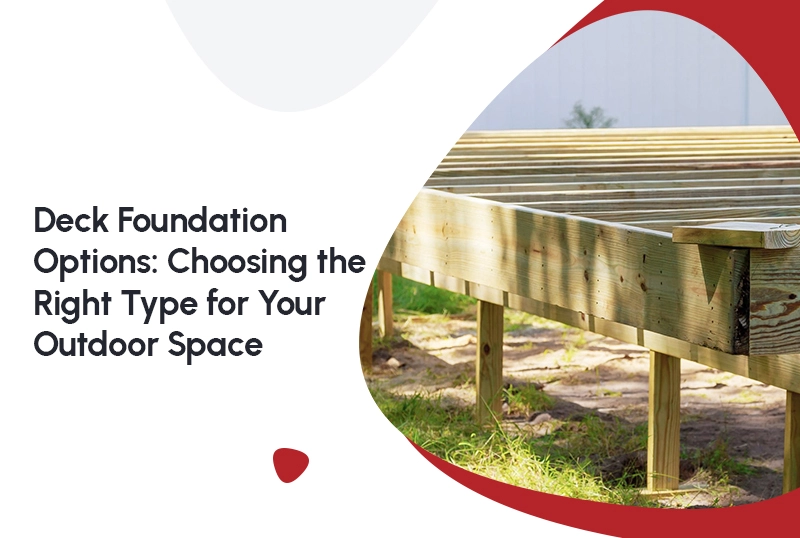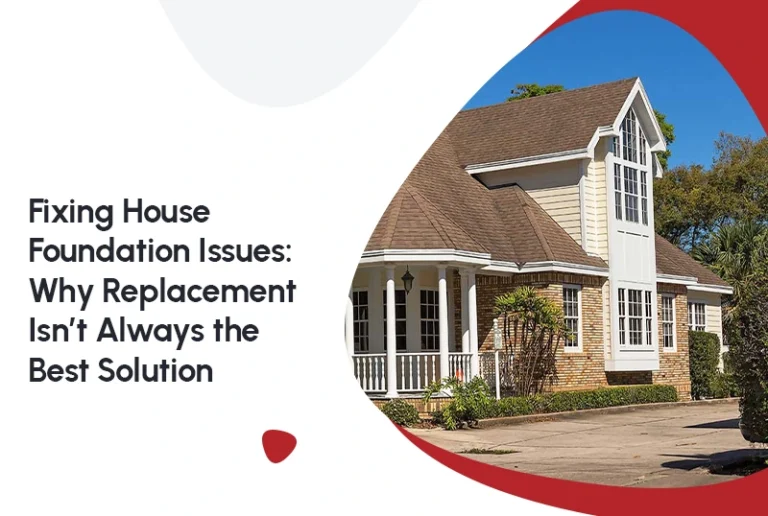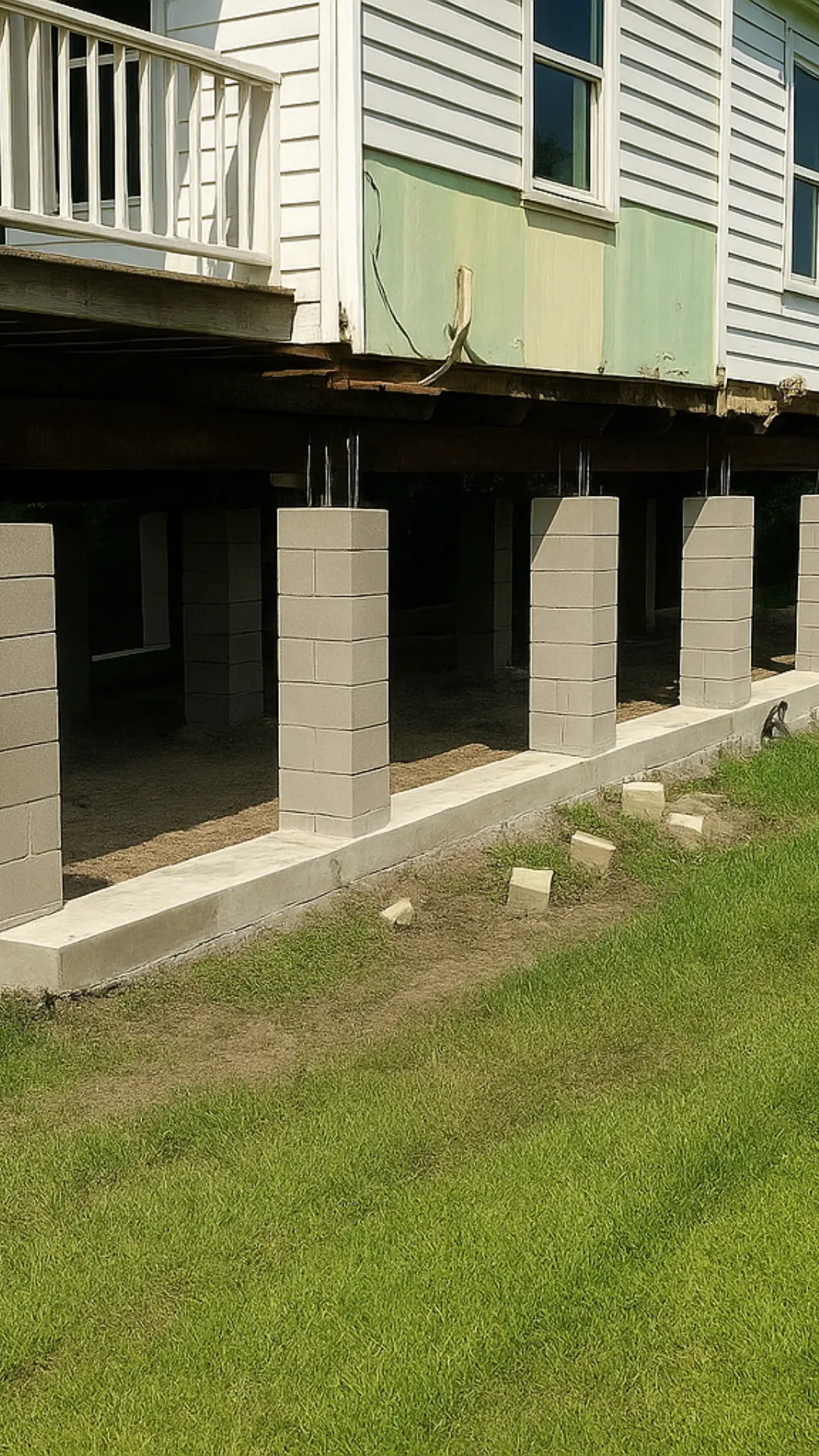Building a deck is one of the best ways to improve your outdoor living area. Whether you’re hosting summer barbecues, relaxing with a good book, or simply enjoying the scenery, your deck becomes a central space for connection and enjoyment. But behind every beautiful and functional deck is a strong, stable foundation. Without it, even the most well-designed deck is vulnerable to damage over time.
In this guide, we’ll explore the different types of deck foundations available, their pros and cons, and offer advice on choosing the best one based on your specific site conditions and design needs. We’ll also cover crucial concepts like house leveling and foundation maintenance, helping you ensure your outdoor space remains safe and secure for years to come.
Types of Deck Foundation
Your choice of foundation is one of the most critical decisions in the deck design process. It not only supports the entire structure but also affects the longevity, safety, and usability of your deck. Let’s explore the most common deck foundation types:
1. Concrete Slab Foundation
A concrete slab foundation is a popular choice for deck foundations, especially in regions with stable soil and relatively flat ground. This method involves pouring a solid concrete slab that acts as a base for the deck structure.
Advantages of Concrete Slab Foundation:
- Provides a level and stable surface to build on
- Highly resistant to moisture and soil movement
- Minimal maintenance and long-lasting durability
This type of deck foundation is ideal for ground-level or low-profile decks and is particularly effective in preventing weed growth or insect infestation underneath the structure. However, it does require precise site preparation. If your ground isn’t naturally level, house leveling may be required before pouring the slab. This ensures the foundation won’t shift, settle, or crack unevenly over time.
Concrete slabs are also cost-effective and quick to install but may be less ideal in flood-prone areas since water can pool on flat surfaces if not properly drained.
2. Pier and Beam Foundation
A pier and beam foundation is constructed by setting vertical piers (posts) into the ground and using them to support horizontal beams that carry the deck. It’s one of the most flexible and commonly used systems for decks, especially in areas with sloped or uneven terrain.
Advantages of Pier and Beam Foundation:
- Allows for natural airflow beneath the deck, reducing moisture build-up
- Flexible in terms of height adjustments and ground variations
- Ideal for sloping land, poor soil conditions, or elevated decks
This foundation also makes it easier to access plumbing, electrical wiring, or irrigation systems that may run underneath the deck.
One consideration with pier and beam systems is foundation settling, especially in areas with expansive or loose soil. Over time, posts may shift or sink. In such cases, house leveling or the addition of deeper footings and concrete supports may be necessary.
3. Post and Beam Foundation
The post and beam method is similar to pier and beam but typically uses larger, deeper-set posts designed to support heavy loads and elevated structures. This method is often used for tall or multi-level decks.
Advantages of Post and Beam Foundation:
- Superior strength for elevated or heavy-duty decks
- Allows access to the underside of the deck for maintenance
- Works well with decking that spans across uneven terrain
These foundations are often reinforced with concrete footings to ensure each post remains stable over time. If the soil beneath is soft or shows signs of erosion, concrete leveling may be needed to provide a flat and strong base for the posts. Post placement also requires precision to ensure proper load distribution and structural balance.
4. Crawl Space Foundation
For decks built in areas that are prone to flooding or with much moisture, a crawl space foundation might be the best option. This involves elevating the deck above the ground on footings, which prevents water from reaching the structure. A crawl space provides airflow underneath the deck, reducing the chance of mold or rot forming.
Advantages of Crawl Space Foundation:
- Prevents water damage from pooling under the deck.
- Provides ample space for utilities.
- It can easily be adjusted or modified if necessary.
However, this type of foundation requires proper tunneling techniques to ensure that there is adequate airflow and that moisture doesn’t build up under the deck. Additionally, it’s important to ensure the footings are placed deep enough into the ground to prevent the deck from shifting or settling.
Choosing the Right Deck Foundation
Choosing the right deck foundation for your deck depends on several factors, including the soil type, climate, and deck design. Here are a few considerations to keep in mind when deciding on a foundation type:
1. Soil Conditions
Soil plays a massive role in the performance of a foundation. Stable, compacted soil can support a concrete slab easily. However, soft, sandy, or expansive clay soils may require deeper footings or pier-based systems to ensure the deck foundation remains level and secure.
If you’re unsure about your soil’s stability, it’s wise to consult a structural engineer or soil specialist before beginning construction. In some cases, foundation repair techniques or soil reinforcement may be needed.
2. Deck Foundation Size and Height
- For ground-level decks, a concrete slab or simple post foundation may be adequate.
- For elevated decks, especially those with stairs or multiple levels, pier or post and beam systems provide better load support and flexibility.
- Larger decks will require more substantial foundations to handle the weight of furniture, people, and weather-related loads (like snow or rainwater).
3. Climate and Weather
- In dry or moderate climates, concrete slabs are affordable and effective.
- In wet or humid regions, pier and beam or crawl space foundations offer better moisture control.
- In cold climates, posts must be set below the frost line to prevent heaving. Crawl spaces and pier systems help mitigate freeze-thaw cycles.
4. Accessibility and Utility Needs
If you need access beneath the deck for maintenance, storage, or utilities, elevated options like pier and beam or crawl space foundations are better choices. These types also make it easier to manage wiring or plumbing for features like outdoor kitchens, lighting, or hot tubs.
Repairing and Maintaining Your Deck Foundation
No matter which foundation type you choose, regular maintenance is crucial to ensure the long-term stability and safety of your deck. Over time, even the most durable foundation may experience wear and tear. Here are a few tips to maintain your deck foundation:
1. Check for Settling
Look for signs such as tilted or uneven deck surfaces, sagging in one area, or gaps between the deck and your home. These are indicators that the foundation may be settling. House leveling or additional supports may be needed to restore balance.
2. Inspect for Cracks and Moisture
Concrete slabs can develop cracks due to expansion or pressure. Small cracks can be sealed with epoxy, but wider cracks should be evaluated professionally. Moisture pooling under the deck may also weaken the footings over time, so ensuring proper drainage is essential.
3. Reinforce with Tunneling or Drainage Systems
If you live in a high-moisture area, tunneling and improved drainage systems can help maintain airflow and prevent structural rot. Tunneling allows for repair or inspection without dismantling the deck and helps protect underground utilities.
4. Seal and Protect Footings
If your posts are made of wood, they should be treated for moisture and insect resistance. Footings that sit above ground can be sealed or covered with concrete piers or brackets to avoid water contact. Routine cleaning also helps prevent algae and mildew buildup.
5. Re-Level as Needed
If you notice your deck becoming slanted or unsteady, re-leveling might be necessary. Concrete leveling or pier adjustments can bring the deck back to its original height. Professional leveling ensures that all areas of the foundation are adjusted evenly to avoid strain on one side.
Conclusion
Choosing the right deck foundation is essential for building a strong, stable, and long-lasting outdoor space. Each foundation type — whether concrete slab, pier and beam, post and beam, or crawl space — has unique benefits and considerations. By evaluating your site’s soil, slope, climate, and design requirements, you can select the most suitable foundation for your needs.
Ongoing maintenance is just as important as choosing the right foundation. With regular inspections, repairs, and reinforcement techniques such as tunneling or concrete leveling, your deck will remain a safe and enjoyable extension of your home for many years.
Whether you’re a DIY enthusiast or working with a contractor, a well-chosen and well-maintained foundation is the cornerstone of every great deck.
FAQs
1. What is the best foundation for a deck?
The best foundation for a deck depends on the deck’s size, height, and soil condition. For most decks, concrete footings are considered the strongest and most durable option. They provide stable support and prevent movement caused by soil expansion or frost heave. In areas with soft or unstable ground, helical piles are a great choice since they screw deep into the soil for extra stability. For smaller or low-level decks, deck blocks can be used as a cost-effective and easy-to-install alternative.
2. What is the best material to put under a deck?
The best material to put under a deck is crushed gravel or stone. It allows water to drain easily and prevents puddling that can lead to moisture damage and wood rot. A layer of landscape fabric beneath the gravel also helps stop weed growth. Avoid using soil or mulch because they retain moisture, which can attract pests and cause structural damage over time.
3. Can I lay decking directly on soil?
Laying decking directly on soil is not recommended because soil shifts, settles, and retains moisture, leading to instability and rot. If you want a ground-level deck, place deck blocks or paver stones on a compacted gravel base to improve drainage and support. This setup keeps the wood elevated, prevents moisture buildup, and extends the life of your deck significantly.
4. What is a deck foundation?
A deck foundation is the base structure that supports the entire deck, transferring its weight to the ground safely. It can consist of concrete piers, deck blocks, or helical piles, depending on the deck’s size and soil stability. A solid foundation ensures the deck remains level, prevents sagging, and resists movement caused by weather or soil changes over time.
5. What is the foundation of a deck called?
The foundation of a deck is commonly called deck footings or deck piers. These are the components that anchor the deck to the ground and provide stability. They can be made of poured concrete, precast blocks, or steel piles. Properly installed footings distribute the load evenly and help prevent structural movement due to frost or soil settlement.
6. How long does a deck foundation last?
A well-built deck foundation can last 25 to 50 years or more, depending on materials and maintenance. Concrete footings have the longest lifespan because they resist moisture and ground movement. However, wooden posts set directly in soil may deteriorate faster without protection. Regular inspections, sealing, and proper drainage help extend the foundation’s lifespan considerably.
7. Can I build a deck without footings?
Yes, you can build a deck without footings, but only if it’s a floating deck or a small, low-level structure. Instead of footings, you can use deck blocks or concrete pads placed directly on compacted gravel. This makes installation easier and avoids digging. However, floating decks aren’t suitable for large or elevated designs because they may shift slightly over time.
8. What is the 3-4-5 rule for decks?
The 3-4-5 rule is a simple method used to ensure a deck’s corners are square during construction. Measure 3 feet on one side, 4 feet on the adjacent side, and 5 feet diagonally between the two points. If the diagonal equals 5 feet exactly, the corner is perfectly square. This technique is based on the Pythagorean theorem and ensures accurate framing and alignment.
9. What are the four types of foundation?
The four main types of foundation are:
- Shallow foundations – used for lighter structures like decks or small homes.
- Deep foundations – include piles or drilled shafts for heavy loads.
- Combined foundations – where two or more columns share one footing.
- Raft or mat foundations – a large concrete slab supporting the entire structure.
For decks, shallow foundations such as concrete footings or piers are most commonly used.
10. Which foundation type is better?
The best foundation type depends on your project and soil condition. For decks, concrete footings are the preferred choice because they offer the best combination of strength, stability, and durability. Helical piles are ideal for poor soil or sloped terrain, while deck blocks are perfect for smaller, portable decks. Consulting a professional can help determine which type suits your property best.



![How Much Does Slab Leak Repair Cost? [2025 Data]](https://fnffoundation.com/wp-content/uploads/2025/07/HowMuchDoesSlabLeakRepairCost2025Data-ezgif.com-jpg-to-webp-converter-768x516.webp)



